list上
文章目录
初步了解list
面试题:为什么会有list?
答:为了解决vector的缺点
vector的缺点:
插入数据需要挪动数据;
插入数据需要增容;
注:
vector和string都是数组,在哪个位置插入数据,后面的数据是要往后挪动位置的;所以时间复杂度是o(n);
而list是链表,插入数据时o(1);
vector、list优点
vector支持下标随机访问;
list头插尾插不需要挪动数据、效率高;并且不需要增容
list结构
本质是带头双向循环链表;
列表种类有哪些?
答:带头、不带头;循环、不循环;单向、双向;这样2^3组合种;
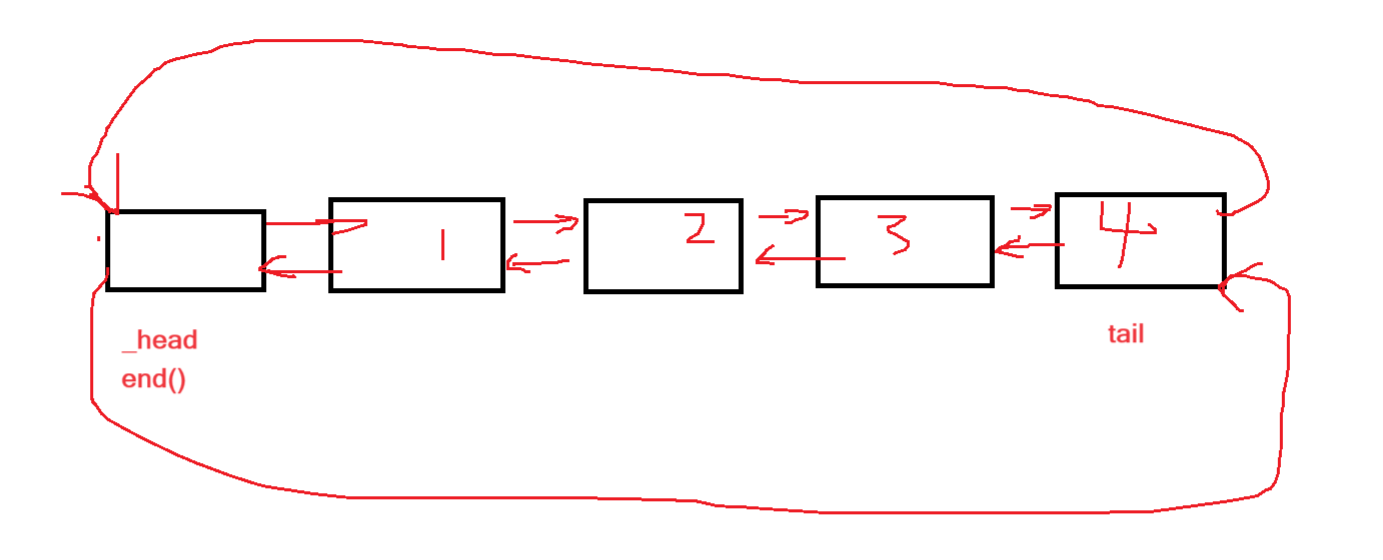
只要一个容器支持迭代器,就可以用范围for遍历;
迭代器的分类
从支持的接口角度:
单向(forward_list)、双向(list)、随机(vector);
一般从使用场景分类:
正向、反向、正向const、方向const;
list的简单运用
#define _CRT_SECURE_NO_WARNINGS
#include<iostream>
#include<list>
using namespace std;
void print_list(const list<int>& l)
{
list<int>::const_iterator it = l.cbegin();
while (it != l.end())
{
cout << *it << " ";
it++;
}
cout << endl;
}
void test_vector1()
{
list<int> l;
l.push_back(1);
l.push_back(1);
l.push_back(1);
l.push_back(1);
l.push_back(1);
l.push_back(1);
list<int>::iterator it = l.begin();
while (it != l.end())
{
cout << *it << " ";
it++;
}
cout << endl;
//拷贝
list<int> l1(l);
print_list(l1);
}
void test_vector2()
{
//insert、erase
//vector的迭代器失效insert、erase都会、list只用erase会迭代器失效
list<int> l1;
l1.push_back(1);
l1.push_back(20);
l1.push_back(3);
l1.push_back(5);
l1.push_back(8);
l1.push_back(10);
print_list(l1);
list<int>::iterator pos = find(l1.begin(), l1.end(), 20);//现在pos就是begin()开始往后面找,里面数值为20的迭代器
l1.insert(pos, 22);
for (auto e : l1)
{
cout << e << " ";
e++;
}
cout << endl;
l1.erase(pos);
l1.insert(pos,11);
print_list(l1);
}
int main()
{
test_vector2();
return 0;
}
insert、erase、迭代器失效(和vector的区别)
插在这个pos位置
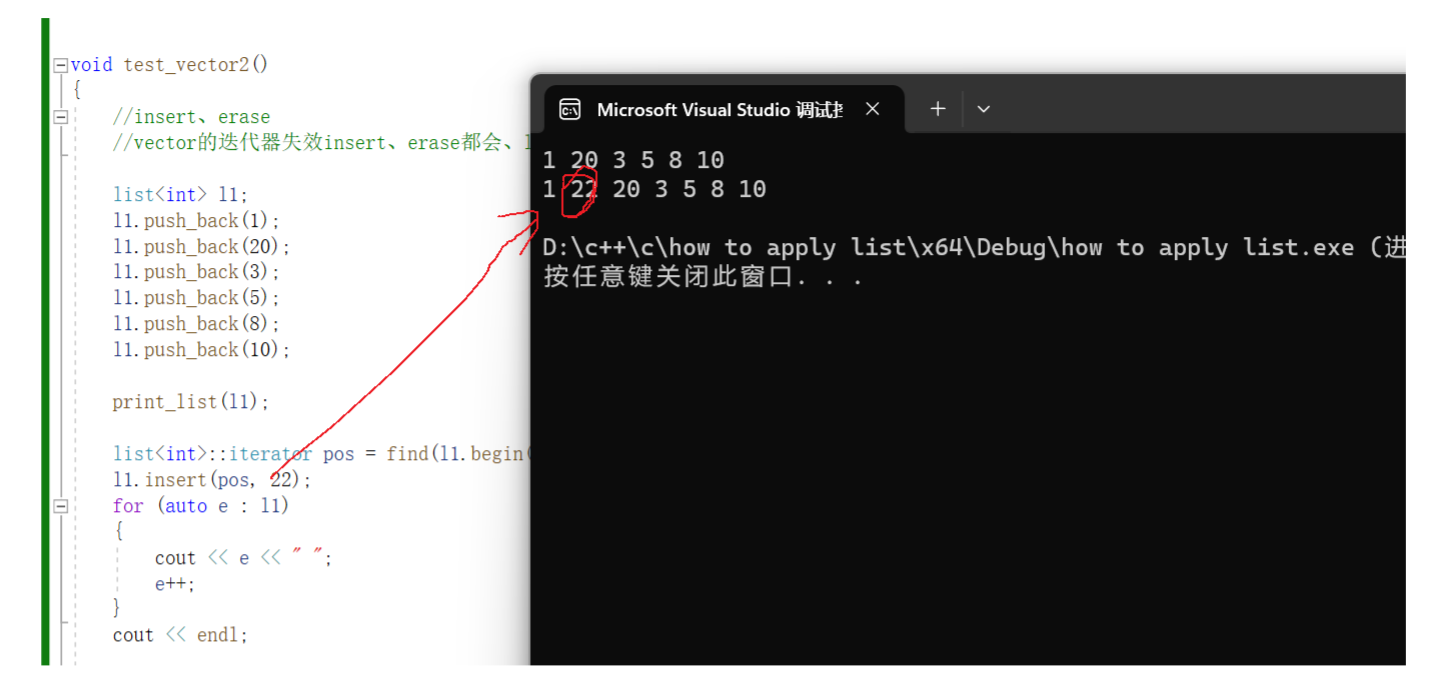
erase
1、这个pos的所指向的仍是指向20的这个迭代器没有变化,因为他是列表;
2、如果是vector或者string那么在insert之后再用pos会发生迭代器失效,为什么?
答:迭代器失效:因为insert之后pos所指向的内容发生了改变,vector和string本质是一个数组中间插入一个数后面数的位置都要改变、pos这个迭代器指向的地址上的内容改变了就会报错,如果发生了增容、那更加错了、增容的话原本这个数组的地址就变了;
而list是列表,列表和数组(数据结构上的内容),列表是里面存了一个数值、然后还存了一个指向下一个列表的指针,所以插入值后pos指向的位置始终不变、只是插入的新的这个数据里面有个指针指向了pos;
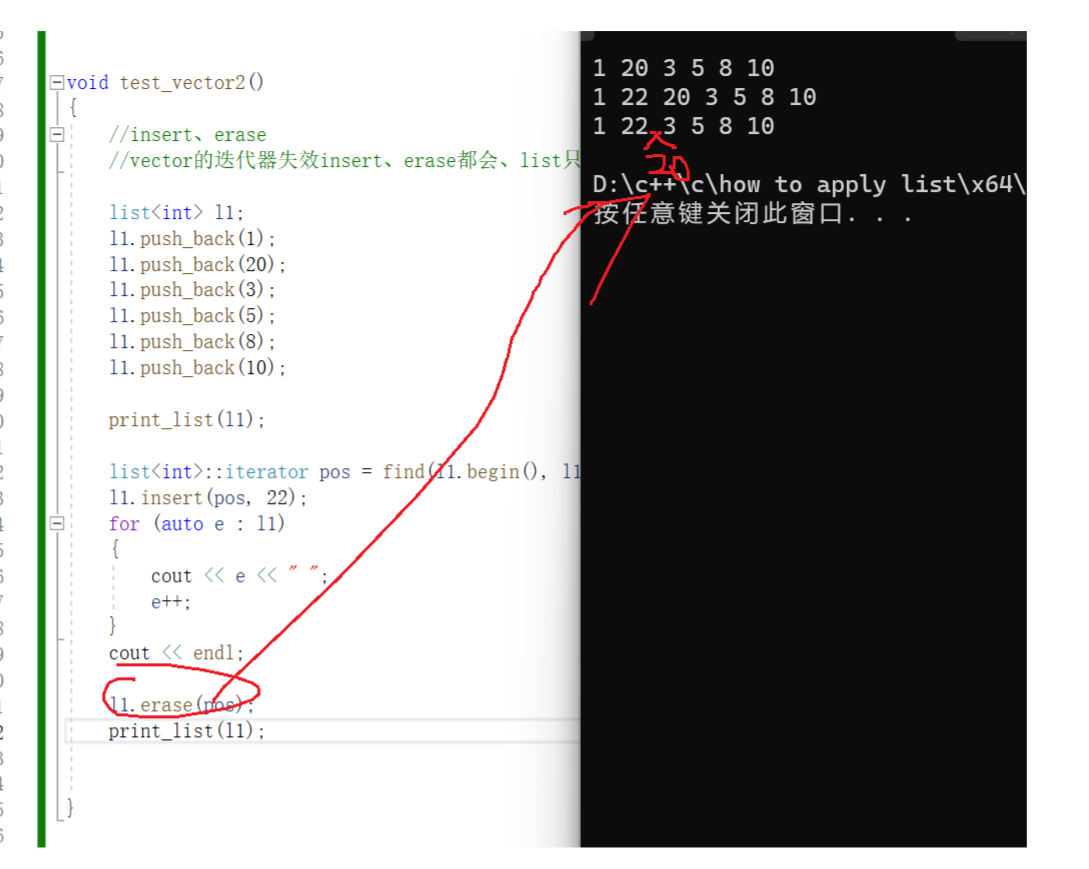
3、erase的话、list和vector都会存在迭代器失效
erase,list是这个pos迭代器,本质就是pos这个指针指向的空间被销毁了;
vector道理相似;
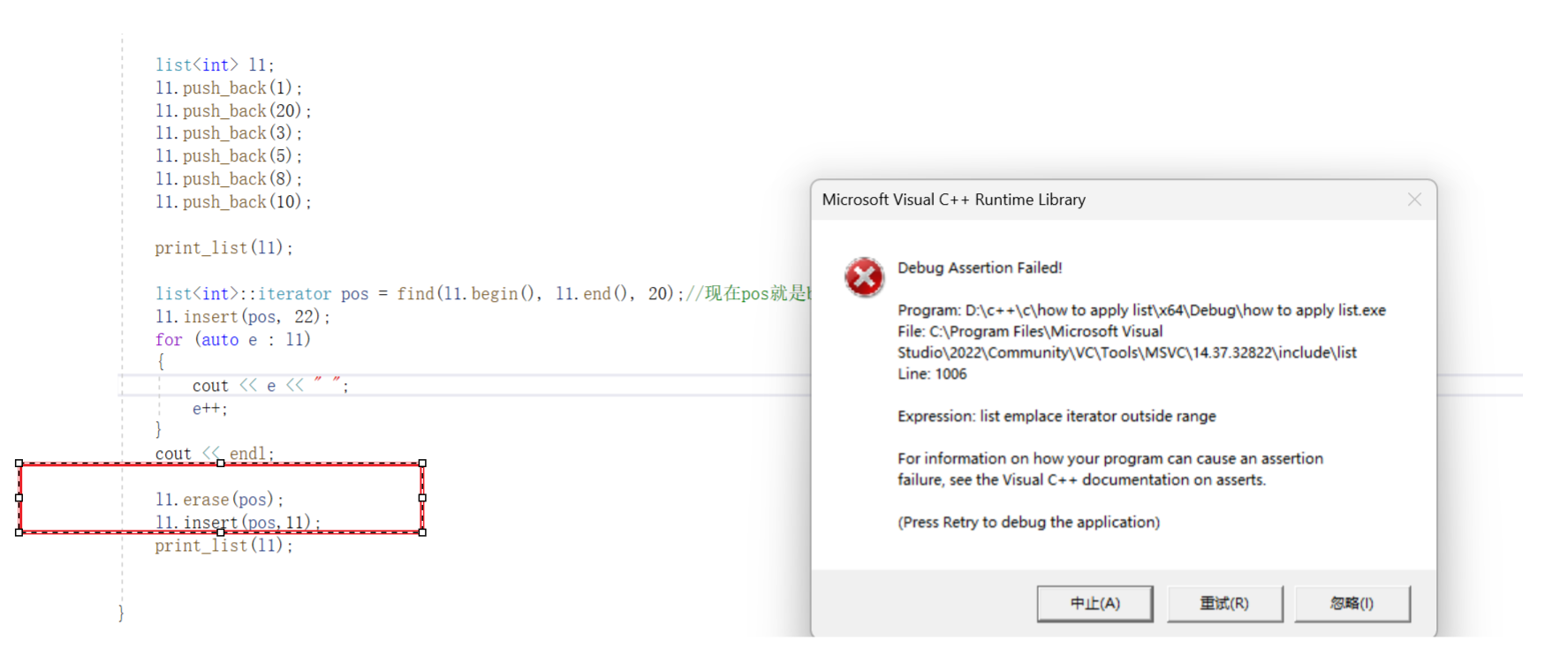
class和struct
struct和class是一样的,只是struct默认是public,class默认是private;
struct内数据默认是public类型的,class内数据默认是private类型的;
struct变量放在栈上,而class变量放在堆上,因此struct变量会自动释放,而class变量需要手动释放;
list的迭代器
是另一个struct出来的,不是列表里面的next和prev指针;


list::iterator it = lt.begin()
为什么这个迭代器的构造函数不用深拷贝?
描述:这个迭代器就不用深拷贝了,用默认的浅拷贝就行了

答:这里直接让他两指向同一个空间,不会像vector、string要深拷贝、比如v1(v2),这个v1、v2浅拷贝的话就是他们内部指针指的位置都一样了,那就是v1释放空间v2也没了,但是迭代器用不到这个功能;
tmp 是一个在函数内部创建的局部变量,但它的引用被返回给调用者。当函数执行完毕或者离开 tmp 的作用域时,tmp 对象本身并不会被销毁,因为它的引用仍然存在于调用者的上下文中。
这意味着,即使超出了包含 tmp 的作用域,tmp 对象仍然存在,并且可以通过返回的引用进行访问。只有当调用者不再使用返回的引用时,tmp 对象才会被销毁。
模拟list
注:
delete和delete[]区别是前者释放单个对象、后者释放数组对象
具体代码
写一个列表的结构体
构造函数以及其中的成员函数
template<class T>
//struct__list_node,两个_这种取名方式一般表示一会这个会在别的里面用,在这里就表示,list类里面直接用的类外面定义的struct __list_code这个结构体
struct __list_node
{
__list_node<T>* _next; // 别忘了这里要写<T>
__list_node<T>* _prev;
T _data;
//列表需要构造函数来初始化
__list_node(const T& x = T())//这个T(),指的是没有传值过来那就直接为0
:_data(x)
,_next(nullptr)
,_prev(nullptr)
{}
};
迭代器
主要用到list里面的两个指针,分别指向前后_next、_prev;
//struct迭代器__list_iterator
template<class T>
struct __list_iterator
{
typedef __list_node<T> Node;
Node* _node;
//构造函数,struct怎么写构造函数、就是看这个里面成员函数有哪些
__list_iterator(Node* node)
:_node(node)
{}
//构造传的是里面的成员函数、拷贝是传的类或者说这个结构体
//浅拷贝,这个是默认函数、不用写的
__list_iterator(const __list_iterator<T>& it)
{
_node = it._node;
}
// operator*,读_node中的data,data的类型是T,所以函数返回值类型是T
T& operator*()
{
return _node->_data;
}
//++
__list_iterator<T>& operator++()
{
_node = _node->_next;
return *this;
}
//后置++
__list_iterator<T> operator++(int) //后置++里面就放个int,这是设计出来的伪参数,用来区分前后置用的
{
__list_iterator<T> tmp(*this); //直接拷贝函数、这个不用写、因为是浅拷贝,深拷贝才要写
_node = _node->_next;
//++(*this);
return tmp;
}
//--
__list_iterator<T>& operator--()
{
_node = _node->_prev; //_node是指针
return *this; //*this就是迭代器,this是指针指向迭代器
}
__list_iterator<T>& operator--(int) //后置++里面就放个int,这是设计出来的伪参数,用来区分前后置用的
{
__list_iterator<T> tmp(*this); //直接拷贝函数、这个不用写、因为是浅拷贝,深拷贝才要写
//node = _node->_next;
--(*this);
return tmp;
}
//!=,两个迭代器之间不相等、迭代器里面的成员函数是_node,比的是这两个,就是他指向一个列表的地址,看这两个地址一样吗
bool operator!=(const __list_iterator<T>& it)
{
return _node != it._node;
}
T* operator->()
{
return& _node->_data;//返回这个地址
//指向这个地址,调用时第一个->返回其地址、第二个->返回地址上的值,迭代器做了优化,调用只需要一个->
}
};
class类
template<class T>
class list
{
typedef __list_node<T> Node;
public:
typedef __list_iterator<T> iterator; // 放public里面不然外面动不了T,就是用不了模板,私有的不能用
//迭代器用节点的指针就行了
iterator begin()
{
return iterator(_head->_next);
//注意这里返回的是迭代器,不是_head头部指针、这个是list类里面的成员变量
//现在是把头部指针_head传过去,然后迭代器调用他的拷贝函数;
//这里面就是构造函数、因为传过去的是Node类型;
}
iterator end()
{
return iterator(_head);
}
//构造函数
list()
{
_head = new Node;//new node //这里面不用写成Node[],是因为[]是数组用的,这个就里面就开辟一个指针指向的地址空间,[]是一个数组的空间
_head->_next = _head;
_head->_prev = _head;
}
void push_back(const T& x = T())
{
Node* tail = _head->_prev;
Node* newnode = new Node(x);
tail->_next = newnode;
newnode->_prev = tail;
newnode->_next = _head;
_head->_prev = newnode;
}
private:
Node* _head;
};
两个测试案例
void test_list1()
{
list<int> lt;
lt.push_back(1);
lt.push_back(2);
lt.push_back(3);
lt.push_back(4);
list<int>::iterator it = lt.begin();
while (it != lt.end())
{
cout << *it << " ";
++it;
}
cout << endl;
}
struct Date
{
int _year = 0;
int _month = 1;
int _day = 2;
};
void test_list2()
{
list<Date> lt;
lt.push_back(Date());
lt.push_back(Date());
list<Date>::iterator it = lt.begin();//调用data,因为现在模板T就是date,传参传过去date是可以的
while (it != lt.end())
{
cout << it->_year << " " << it->_month << " " << it->_day;
++it;
}
cout << endl;
}
报错
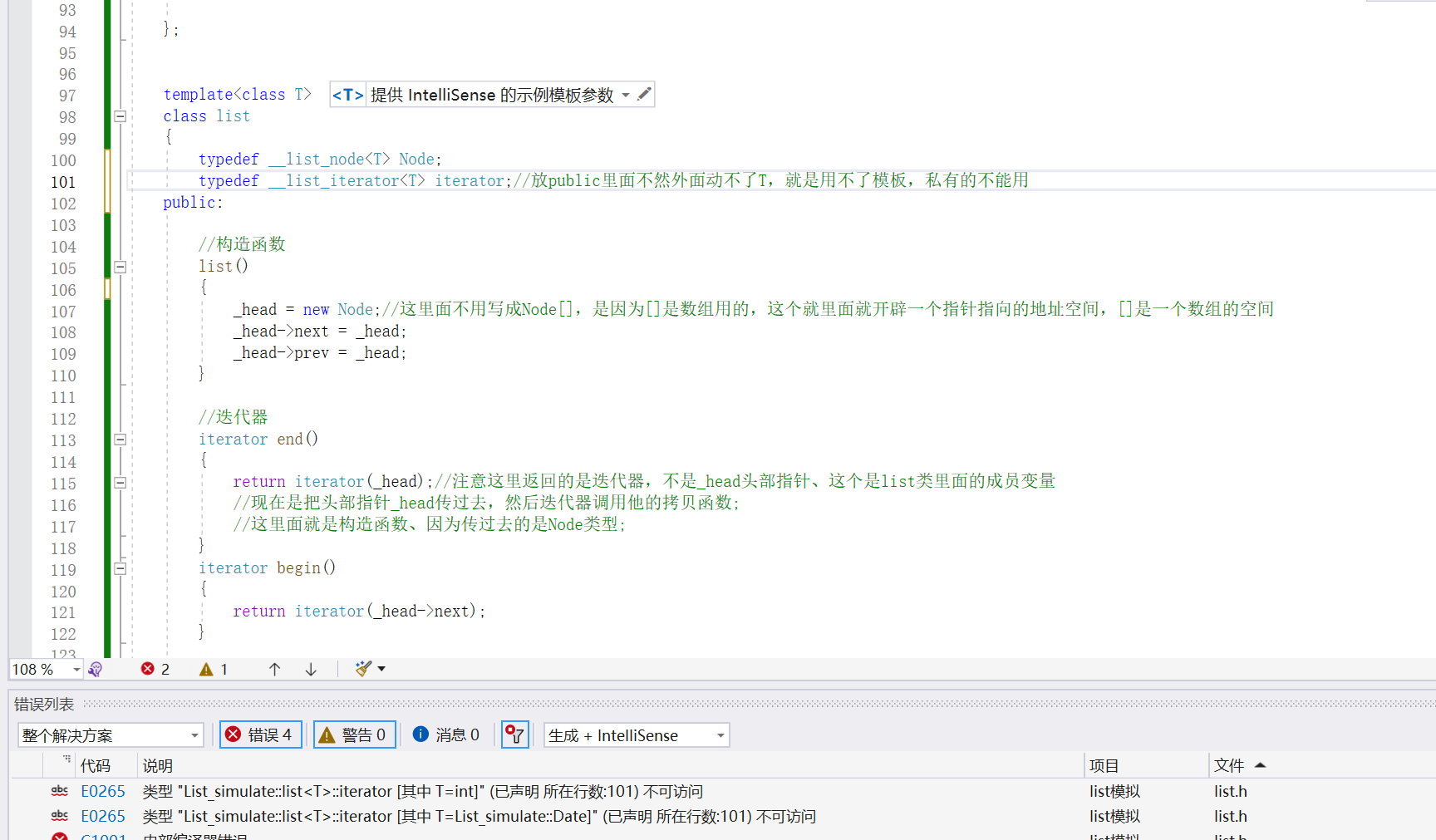
修改
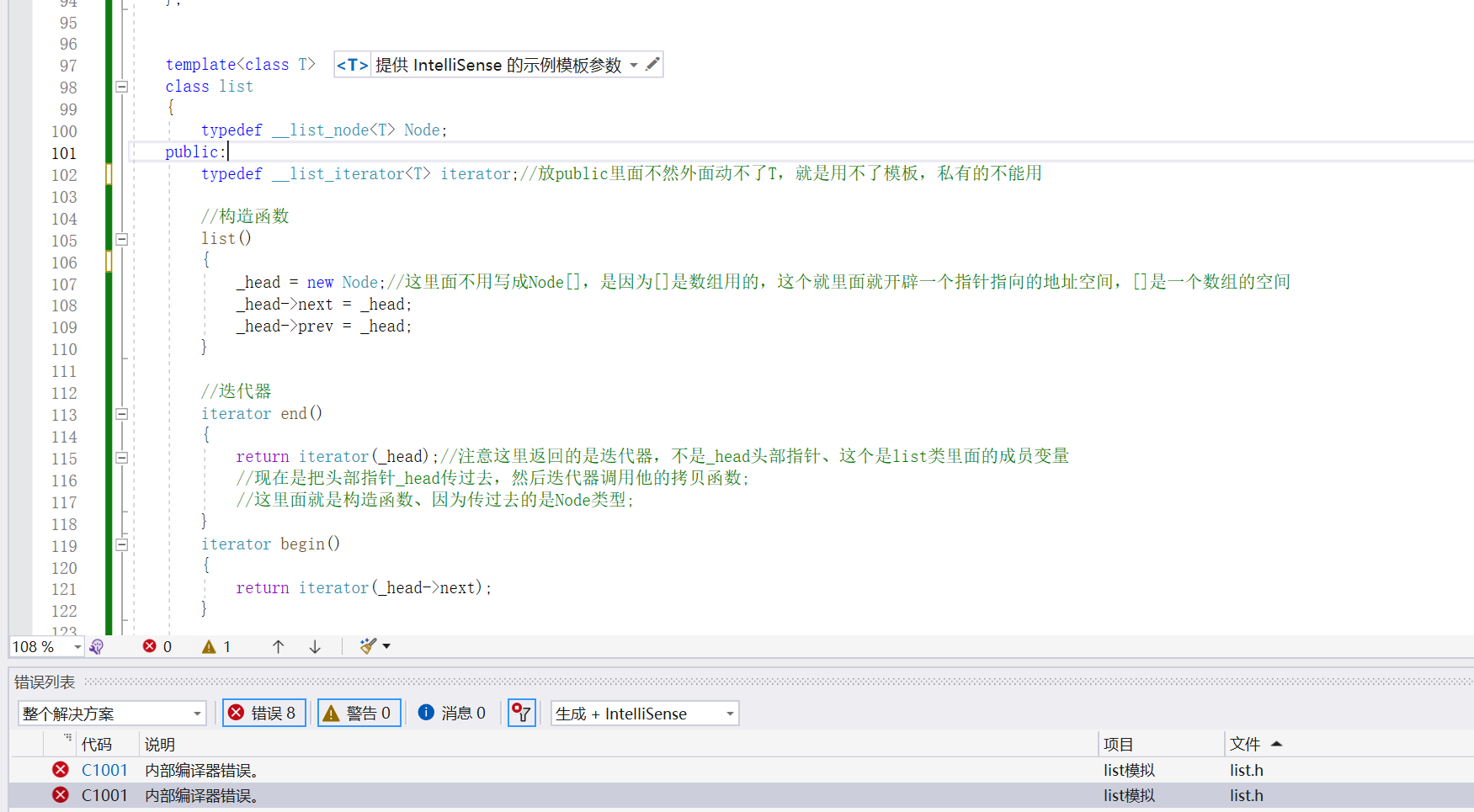
本文来自互联网用户投稿,该文观点仅代表作者本人,不代表本站立场。本站仅提供信息存储空间服务,不拥有所有权,不承担相关法律责任。 如若内容造成侵权/违法违规/事实不符,请联系我的编程经验分享网邮箱:chenni525@qq.com进行投诉反馈,一经查实,立即删除!
- Python教程
- 深入理解 MySQL 中的 HAVING 关键字和聚合函数
- Qt之QChar编码(1)
- MyBatis入门基础篇
- 用Python脚本实现FFmpeg批量转换
- GBASE南大通用数据库GBase 8s常见问题讲堂 -- no more pages/no more extents
- 怎么做一个包含多图的二维码?图片怎么放到二维码中去?
- error_ Microsoft Visual C++ 14.0 or greater is required. Get it with “Microsoft C++ Build Tools“_ h
- C++函数重载:解密性质、使用方法、特点与语法
- 深信服技术认证“SCSA-S”划重点:逻辑漏洞
- 一、C++初识
- 程序员熬夜补救指南
- java api中文源码——基于java8 src.zip
- Ubuntu 安装Docker
- 【每日一题】移除石子使总数最小